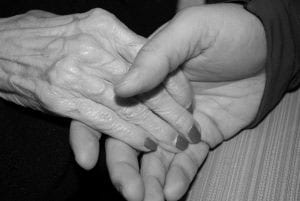My name is Casey. I’m 27 years old and have a 50% chance of becoming symptomatic for a neurodegenerative disease in my 30’s (if my onset aligns with that of my mother’s), but I consider myself lucky.
First off, let’s tackle some important basics. Huntington’s disease (HD) is an inherited, neurodegenerative disease. It’s kind of like having ALS, Alzheimer’s, and Parkinson’s combined into one. HD typically onsets from ages 30-40.
I am what the HD community considers “at-risk” which means that one of my parents is known to have the disease, but I have yet to be tested. I would like to share with you a little bit of my story and my attempt to take some control over my Huntington’s disease predisposition.
My Huntington’s Story
My mother, Kimberly Herrington, suffered from Huntington’s disease. Growing up, my sister and I learned firsthand of the devastating nature of HD as our mother experienced symptom-onset in her early thirties. Coming from a broken family, we did not discuss HD, not even when the symptoms became noticeable. As the disease progressed, my mother suffered the full wrath of the disease, and at the age of 46, she passed away. At her funeral, my sisters and I were reunited with our two younger half-sisters that were taken away from my Mom while they were little. The experience was an emotionally turbulent time for me. Although I was angry that HD had claimed the life of my mom, I felt relief that she was not suffering any longer and felt happiness that I was reunited with my younger sisters. The day of my mother’s funeral, I made a conscious decision to set my sights on championing the fight by working towards creating a world without Huntington’s disease.
Finding a Huntington’s Community
I started making phone calls and talking with anyone who would talk with me about the HD community. I was ultimately connected with Jack Griffin, who owns the Griffin Foundation based in Washington, DC. After many good conversations, we finally decided to move forward with a platform that would aggregate resources in the HD community and highlight all of the players in the HD community through an ecosystem map.
I initially planned to work closely with someone to develop the platform while I managed all of the research and community engagement, but ultimately that is not how it worked out. I ended up having to teach myself software development as I built HD GEM. The project started in January 2018 and launched in April of that same year. Since then, I’ve had the opportunity to travel and speak with so many people in the Huntington’s disease community.
The Importance of Resources
In my experience, I’ve seen two types of HD families. The first type are families that are proactive. They take advantage of the resources that are available and as a result they experience a higher quality of life both for themselves and for the person who is suffering from HD. Then on the other side, you have families that metaphorically stick their heads in the sand. They don’t engage with the resources that are available to them. From what I’ve seen, they don’t fare as well, and their quality of life isn’t as good as it could be.
Hopefully, after reading a little bit of my story, you will understand why HD GEM exists and the passion behind it. HD GEM exists to lower the barriers of understanding about what resources exist so that people can become more proactive and experience a higher quality of life.
So why do I consider myself lucky? Because I have time, and that is better than not having time. I’ve been given an opportunity to try to make a difference for a group of people that mean a lot to me, and I plan to continue that path for as long as possible.
To visit HD GEM click here.








